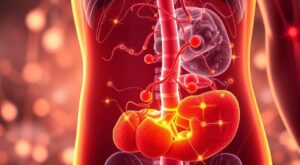Are you ready to start a low-carb diet and face the challenges it brings? Many think a low-carb diet is just for quick weight loss and more energy. But, there are side effects you might not know about.
Starting a low-carb diet can be a big change. It’s important to know about the side effects to succeed. In this article, we’ll look at five surprising side effects of low-carb diets.
Understanding the Low-Carb Diet
If you’re new to low-carb diets, it’s key to know the basics. These diets cut down on carbs, making your body use fat for energy. This change can lead to weight loss and better health.
What is a Low-Carb Diet?
A low-carb diet means eating fewer carbs and more proteins and fats. It can change a lot based on your goals. You might aim to eat 20 to 150 grams of carbs a day.
Common Types of Low-Carb Diets
- Keto Diet: A very low-carb, high-fat diet that aims to induce ketosis.
- Atkins Diet: A renowned diet known for its four phases that gradually increase carb intake.
- Paleo Diet: A focus on whole foods that our ancestors might have eaten, stressing meats and veggies.
- South Beach Diet: A phased approach to low-carb eating with a balance of nutrients.
How Low-Carb Diets Work
It’s important to understand how low-carb diets work. By eating less carbs, your body enters ketosis. In this state, it uses fat for energy instead of carbs. Getting the right balance of nutrients helps you reach your health goals.
Benefits of a Low-Carb Diet
Exploring the benefits of a low-carb diet can be enlightening. It offers many advantages, not just for weight loss. It can also improve your overall health and well-being. Starting a low-carb diet can lead to quick changes in your body and energy levels, making it a rewarding journey.
Weight Loss and Energy Boost
One of the main benefits of a low-carb diet is its ability to burn fat. By eating fewer carbs, your body uses fat for energy instead of sugar. This can lead to weight loss and more energy. It helps you stay active and supports your weight loss goals.
Improved Blood Sugar Control
Another benefit is better blood sugar control. Low-carb diets help keep insulin levels stable, which balances blood sugar. This can lower the risk of insulin resistance and improve your health. It also helps you manage cravings and eat healthier.
Appetite Suppression
Low-carb diets also help control hunger. They reduce cravings and make you feel full longer. This makes it easier to stick to your diet and resist unhealthy foods. It helps you develop healthier eating habits.

Preparing for Your Low-Carb Journey
Starting a low-carb diet can seem daunting at first. But with the right steps, it can be a smooth transition. Knowing what foods to eat, planning meals, and having the right kitchen tools will help you succeed. This way, your low-carb journey can be enjoyable and lasting.
Essential Foods to Include
It’s key to stock up on the right low-carb foods for your diet. These will be the base of your meals and snacks:
- Leafy greens such as spinach, kale, and Swiss chard
- Non-starchy vegetables like bell peppers, zucchini, and broccoli
- High-quality proteins including chicken, fish, and eggs
- Healthy fats like avocados, olive oil, and nuts
- Low-carb dairy products such as cheese and Greek yogurt
Meal Planning Tips
Here are some tips to make your transition easier:
- Plan your meals for the week, making sure to include a variety of low-carb foods.
- Batch cook proteins and vegetables for quick, ready-to-eat meals.
- Make a shopping list based on your meal plan to avoid buying unnecessary items.
- Try out new recipes using the low-carb ingredients you’ve chosen.
Kitchen Tools for Success
Having the right kitchen tools can make cooking easier:
- A high-quality chef’s knife for easy chopping of vegetables
- A slow cooker or Instant Pot for efficient meal preparation
- A food processor for making dips, sauces, and chopping ingredients
- Meal prep containers to store your prepared meals
By focusing on the right foods, planning well, and using essential kitchen tools, you’re ready to start a low-carb lifestyle. Prepare ahead and enjoy the journey.
The Importance of Hydration
Hydration is key, but even more so on low-carb diets. Cutting carbs changes how your body holds water. It’s important to know how to stay hydrated to enjoy the diet’s benefits.
How a Low-Carb Diet Affects Hydration
Low-carb diets can make you lose water weight at first. This is because carbs bind to water in your body. When you eat fewer carbs, you lose this water. So, you need to drink more water.
Tips for Staying Hydrated
Here are some tips to stay hydrated on a low-carb diet:
- Drink lots of water, herbal teas, and infused waters all day.
- Eat foods with lots of water, like cucumbers, lettuce, and watermelon.
- Watch your electrolyte levels, like sodium, potassium, and magnesium, to help stay hydrated.
- Drink water at set times to make it a habit.
Signs of Dehydration
Staying hydrated is very important, even more so on a low-carb diet. Look out for these signs of dehydration:
- Dry mouth and throat
- Fatigue or weakness
- Dizziness or lightheadedness
- Dark-colored urine
Spotting these signs early helps you meet your hydration needs on a low-carb diet.

| Dehydration Signs | What to Do |
|---|---|
| Dry mouth | Increase water intake immediately. |
| Fatigue | Rest and hydrate frequently. |
| Dizziness | Drink fluids slowly and sit for a while. |
| Dark urine | Stay hydrated and monitor urine color. |
Adjusting to the Low-Carb Lifestyle
Starting a low-carb lifestyle can change your body in many ways. You might feel different as you begin eating this way. Knowing what to expect can make the early days easier.
Initial Symptoms to Expect
When you start a low-carb diet, you might feel some common symptoms. These are often called “keto flu.” You might feel:
- Fatigue and lethargy
- Headaches
- Cravings for carbohydrates
- Irritability
It’s important to know about these symptoms. They are part of adjusting to a low-carb diet. Knowing this can help you feel better during this time.
Strategies to Overcome Challenges
There are ways to make the transition easier. Here are a few tips:
- Gradually reduce carbohydrate intake: Cutting carbs too fast can make symptoms worse. Try reducing them slowly over a week or two.
- Stay hydrated: Drinking lots of water can help with symptoms and keep your energy up.
- Increase electrolytes: Eating foods high in sodium, potassium, and magnesium can help manage side effects.
Using these strategies can make your transition smoother. It will help you stick to the low-carb lifestyle.
Long-Term Adaptation
Adapting to a low-carb diet long-term takes time. But, many people find they have more energy and feel better overall. It might take a few weeks to notice these changes.
Staying consistent and tracking your progress can build your confidence. Remember, everyone adapts at their own pace. Be patient with yourself.

| Symptoms | Duration | Management |
|---|---|---|
| Fatigue | 1-2 weeks | Increase hydration, balance electrolytes |
| Headaches | 1-3 days | Stay hydrated, gradual carb reduction |
| Cravings | 1-2 weeks | Plan meals, eat nutritious snacks |
| Irritability | 1-2 weeks | Ensure adequate sleep, seek support |
5 Surprising Side Effects
Starting a low-carb diet changes more than just your food. You might see many surprising side effects that affect your body and mind. This section looks at unexpected changes, like better mental clarity, digestive health, and mood.
Mental Clarity and Focus
Low-carb diets often lead to better mental clarity. Many people notice they focus better and think more clearly after a short time. This is because fewer carbs help keep blood sugar steady, giving you more energy and sharp thinking.
Changes in Digestive Health
Some people find their digestion improves on low-carb diets. But, others might feel uncomfortable. This is because cutting out carbs can be hard on your gut. Eating veggies can help keep your digestive system healthy during this change.
Impact on Physical Performance
Your sports performance might change when you start eating less carbs. Some see a drop in endurance at first. But, others find they use fat better for energy, leading to better performance over time. It’s important to understand this balance if you’re active and on a low-carb diet.
Effects on Mood and Energy
How a low-carb diet affects your mood can vary. Some feel more energetic and less anxious, while others might get irritable. Paying attention to how you feel can help you see how your diet affects your mood and overall health.

Troubleshooting Common Issues
Starting a low-carb lifestyle can come with challenges. This section offers strategies to overcome these hurdles. You’ll learn how to handle cravings, manage carb flu, and navigate social situations while sticking to your diet.
Dealing with Cravings
Cravings can test your commitment to a low-carb diet. Here are some tips to help you manage them:
- Stay Hydrated: Sometimes, thirst feels like hunger. Drinking water can help curb cravings.
- Incorporate Healthy Fats: Foods rich in healthy fats, like avocados or nuts, can keep you satisfied and reduce the desire for carbs.
- Planned Treats: Allow yourself low-carb snacks like dark chocolate or cheese to satisfy your sweet tooth without derailing your diet.
Managing Carb Flu Symptoms
Many people experience carb flu when starting a low-carb diet. Symptoms include fatigue, headaches, and irritability. Here are some effective strategies for carb flu management:
- Increase Electrolyte Intake: Consuming foods high in potassium, magnesium, and sodium can help alleviate symptoms.
- Gradual Reduction: Slowly lowering carb intake can help minimize discomfort.
- Rest and Sleep: Prioritize sleep to help your body adjust more comfortably to the new eating plan.
Navigating Social Situations
Social events can be tricky on a low-carb diet. Here are tips to help you navigate social situations on a low-carb diet:
- Communicate Your Preferences: Inform friends or family about your dietary choices, so they can accommodate your needs.
- Bring Your Own Dishes: Preparing low-carb options ensures there are suitable choices available.
- Focus on Protein and Vegetables: At gatherings, opt for meat, cheese, and veggie-based dishes to keep your nutrition goals intact.
| Common Issues | Solutions |
|---|---|
| Cravings | Stay hydrated, incorporate healthy fats, enjoy planned treats |
| Carb Flu Symptoms | Increase electrolyte intake, gradual reduction of carbs, prioritize rest |
| Social Situations | Communicate preferences, bring your own dishes, focus on proteins and veggies |
Finding Support and Resources
Starting a low-carb diet can change your life. But, having the right support is key. Connecting with others who have similar goals can give you motivation and encouragement. You’ll find many resources to help you succeed in your low-carb lifestyle.
Online Communities and Forums
Online low-carb communities are great for sharing tips and recipes. Forums for low-carb diets let you ask questions and get advice from those who’ve been there. These places make you feel like you belong and offer insights to improve your journey.
Recommended Books and Blogs
Looking into respected books and blogs can teach you a lot about low-carb diets. Resources for beginners cover meal planning to nutritional science. Check out *The New Atkins for a New You* or *Keto Connect* for helpful information for beginners.
Apps for Tracking Progress
Using low-carb diet tracking apps can make your journey easier. These apps let you log meals, track nutrients, and set weight loss goals. Apps like MyFitnessPal and Carb Manager are easy to use and help you stay on track.
Success Stories and Testimonials
Real-life changes can really motivate people thinking about a low-carb diet. Many have seen big improvements in their health and looks. These low-carb diet success stories show not just weight loss but also a new energy and life.
Real-Life Transformations
Many testimonials show the big impact of a low-carb diet. People have lost a lot of weight and feel more energetic. Some have lost up to 80 pounds in over a year.
They also report less inflammation, better sleep, and clearer thinking. These changes boost confidence and improve life quality.
These stories show not just physical changes but also a boost in confidence. People feel more alive and full of energy.
Lessons Learned from Experienced Individuals
Experienced people share key lessons for beginners. They stress the need to plan meals and drink plenty of water. They also talk about overcoming cravings and dealing with social situations.
These lessons help you face challenges head-on. Each story offers valuable advice and inspiration. They show how a low-carb diet can change your life, not just your body.
Discover more inspiring stories at this link. See how others have made lasting changes in their lives.
Conclusion: Embracing Your Low-Carb Journey
As you finish learning about the low-carb diet, think about what you’ve learned. A low-carb lifestyle can lead to weight loss, more energy, and better blood sugar control. But, you might face cravings and social challenges. Every step you take is a step towards better health.
To keep a healthy lifestyle on a low-carb diet, be consistent. Eat nutrient-rich foods, stay active, and connect with supportive groups. These actions help you stick to your low-carb habits and feel proud of your progress.
If you’re new to this, remember that everyone’s journey is different. Be kind to yourself as you adapt and ask for help when you need it. The journey to better health is rewarding, and each small win builds your confidence. Embrace your low-carb lifestyle with excitement and look forward to the positive changes ahead.














